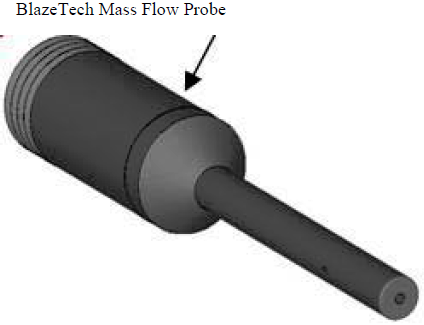Measuring Particles Mass Flux in Air Flows
From Internal Detonations or Volcanic Eruption
Summary
We developed a novel probe for the characterization of particle-laden flows in the opaque, harsh, transient environment of a blast. This probe measures the gas flow properties (temperature and static and dynamic pressures) as well as the particles mass fluxes. Thus, the particle-laden flow is fully characterized.
The probe design evolved based on lessons learned from bench scale and field tests and computer simulations. The proof of principle was demonstrated by comparing the probe outputs with independent measurements of particle mass flux and velocity under well controlled bench-scale conditions. In field tests performed by the Air Force, the probe measurements of the gas flow properties were in good agreement with those obtained by other organizations. In addition, the probe was unique in determining the mass flux of particles in the flow and this measurement was in good agreement with the actual value of particles released in the test.
Probe Specifications
The probe is fairly compact, rugged, streamlined and has a time constant of about 0.5 to 1 ms. It is made of stainless steel and consists of a 12.5 mm ID tube that transitions into a 33.4 mm cylindrical base with an overall length about 250 mm (10 inches) as shown below. The probe is designed to measure particles flows with a mean diameter ranging from 1 to 40 μm. It can measure a wide range of particle mass fluxes depending on the particle speed. For example, for a speed between 100 and 200 m/s (330 and 660 ft/s), it can measure mass fluxes between 0.35 and 70 kg.m-2.s-1 (0.07 and 14 lb.ft-2.s-1).

Anticipated benefits for the Military
The probe can be used to measure the mass flux of the fine particles in a transient pulse. This measurement can be used to quantify the extra loading on structures produced by the fine debris entrained by a detonation, the particles source term in dispersion calculations if the particles were toxic, and the extent of particle reaction in explosives or propellants loaded with reactive particles. These measurements would benefit weapon developments and the investigation of weapon lethality, target vulnerability and collateral damage as well as the validation of related models and simulations. Potential military users include the DOD organizations such as the Air Force, the Army, the Navy, and DTRA and their contractors.
Commercial Applications
Commercial applications and potential users include measuring (1) the mass flux of fine particles in pneumatic transport (such as coal, grains, etc.) in the power generation, food and cement industries; (2) the concentration of water droplet/ice particles in fast-moving clouds in the environmental and meteorological industries, and (3) the ash concentration in volcanic clouds by research and commercial aircraft that may fly through these clouds.
Commercialization Partners
We are seeking partners to commercialize this technology.
